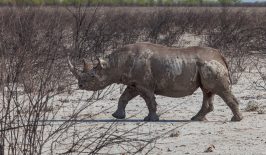A new satellite collaring initiative aims to bolster the dwindling elephant numbers in Tanzania’s national game reserves.
The WWF, in conjunction with the government of Tanzania, has launched an unprecedented collaring operation which aims to greatly increase the efficiency and impact of conservation efforts in the Selous Game Reserve.
The collars, which communicate with mobile devices via satellite, allow rangers and conservationists to track the movement of the reserve’s elephants with much greater speed and accuracy. This means rangers now have the ability to respond instantly to real-time threats affecting the elephants, or predict future potential issues – for example a herd of elephants moving towards a settlement.
Most importantly, the technology will greatly benefit the decision-making of the conservationists by providing them with raw, reliable and actionable data, as Asukile Kajuni, Deputy Programmes Coordinator WWF-Tanzania explained:
“In a landscape as vast as Selous where poaching continues, better information on the whereabouts of elephants is critical to anticipate the risks they may encounter, including fatal attacks by poachers. The collars mark an important first step in the zero poaching approach we are taking by enabling wildlife protection teams to be on the front foot against poaching attacks.”
Initially, the team hopes to collar sixty elephants in the park over a period of twelve months. Each elephant will have to be tranquilized with a dart, before being collared and measured for other health data. The animal is then administered an antidote to the tranquilizer and allowed to reunite with the herd. All-in-all, the process takes only thirty minutes.
Currently, the biodiversity conservation sector has been on the receiving end of many innovative high tech solutions, including drones, facial recognition technology, infrared AI-assisted cameras and patrol tracking apps. Although these gadgets provide rangers with a competitive advantage over the poachers, the best tools will always be those which can support and improve traditional knowledge-based rangering – such as these satellite collars.
The WWF understands this only too well, which is why they are also assisting the park authorities in other important areas. To achieve the zero poaching future the WWF envisions, they are also working with local communities to recruit local village game scouts as well as ensure locals are properly educated about the benefits of elephant conservation. Additionally, the game reserve also needs to ensure it has access to enough properly trained and equipped rangers who can identify other evidence of poaching, such as snares, traps and former campsites. Finally, the WWF is also working with judges and courts to ensure that caught poachers are properly tried and sentenced.
Hopefully, the widespread use of this satellite collar technology will endow the conservationists with the tools they need to rebuild the elephant population in Selous. In the last forty years, the game reserve has seen a ninety per cent drop in their elephant population, from 110,000 in the 1970s to around just 15,200 today.






